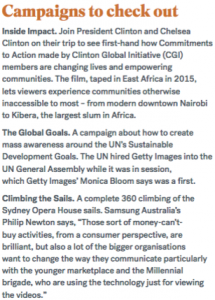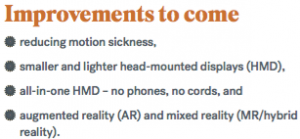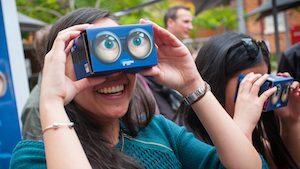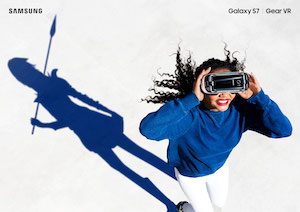Virtual reality feature: the empathy machine
Share
Julie Berry explores why virtual reality (VR) technology will impact our lives in a way even the most tech-savvy among us will struggle to conceive.
This article originally appeared in The Content Issue, our August/September 2016 issue, of Marketing.
 Until you put a headset on for the first time, it is hard to comprehend the VR concept and how it will fit in to everyday life. The better quality headset you can get your hands on, the better idea you will have. So, how are some of Australia’s largest companies such as Google, Samsung and Getty Images staying ahead in this fast-paced, democratised environment, and what tips do they have for brands considering a sortie into this new channel for the masses?
Until you put a headset on for the first time, it is hard to comprehend the VR concept and how it will fit in to everyday life. The better quality headset you can get your hands on, the better idea you will have. So, how are some of Australia’s largest companies such as Google, Samsung and Getty Images staying ahead in this fast-paced, democratised environment, and what tips do they have for brands considering a sortie into this new channel for the masses?
The technology
Companies like Samsung have been looking at VR for more than a decade in different guises. Think 3D TV. Samsung Electronics Australia’s corporate vice president and CMO, Philip Newton, says 3D TV was the first foray into trying to create some sort of VR type solution.
“But that obviously didn’t provide the kind of necessary immersion that the headset does, so sometime later when the computing power that you can get in a handset grew – a couple of years now – we realised that we could do everything we wanted to originally do, in the one area, in the one device. Currently, you’re talking about two separate devices – the handset and the headset – and longer-term, who knows? It could just be incorporated into one device. It’s yet to be seen.”
 Newton suggests, from an R&D perspective, every scenario is being looked at, including potential for a Google Glass type development. For now though, Gear VR, released last November, has been well-received with some calling it the best on the market in terms of usability and price point. This makes up for trailing Rift and HTC Vive in graphics, with those technologies coming with a larger price tag and restrictive tethering requirements.
Newton suggests, from an R&D perspective, every scenario is being looked at, including potential for a Google Glass type development. For now though, Gear VR, released last November, has been well-received with some calling it the best on the market in terms of usability and price point. This makes up for trailing Rift and HTC Vive in graphics, with those technologies coming with a larger price tag and restrictive tethering requirements.
Things change quickly and, although Newton acknowledges that Samsung wasn’t and still isn’t across this disruptive tech, Gear VR was originally built with the mass market consumer in mind – a consumer device that everyone can use. “Was there discussion around verticals? Absolutely. What we didn’t understand was, I guess, the depth and breadth of possibility, and that’s really shown itself in the last 18 months.
“VR was an unmet need that was just waiting to happen, and when we launched our developer products 18 months or so ago, that was the realisation. Since then we’ve just gone on to provide more and more quality and technology and processing power that consumers are telling us they needed, and that will continue for as long as consumers are using the product and wanting the product.”
Major progress over this 18-month period is a common theme. Although Getty Images has been collecting 360-degree images for the past five years, it was essentially directed by technology.
Stuart Hannagan, Getty Images Australia’s VP of editorial imagery, explains the challenges faced. “It wasn’t an easy thing to do five years ago, as a photographer, to go out, cover an event, do what they needed to do from an editorial perspective, capture great pictures, get the moment and then think about a 360-camera, which was a big clunky thing they had to pull out of a bag and put up a tripod. It was really hard work.”
Hannagan admits that back then they weren’t even sure how they would be using the imagery. The potential of 360 became clearer when in 2014 the hardware began to evolve. “360 cameras became incredibly easy to handle, to use, and all of a sudden, especially in the last 18 months, the cameras came out that didn’t need stitching,” Hannagan says.
The process evolved from taking a 360 picture on a very expensive camera and sending it off to be stitched, taking two or three days “if you were lucky”, to today where Getty Images is able to upload images immediately.
Getty Images’ head of global integrated marketing, Monica Bloom, says the company has visual anthropologists on staff to identify trends now and over the next five years. “We’re looking at virtual reality as a much bigger area for us, so in the creation of the Virtual Reality Group it’s really about how we create immersive images for our customers.”
It is achieving this through technology such as 360 and Gigapixel, the latter so incredibly detailed you can zoom in to see a spectator’s lapel pin at the Australian Open.
“It makes you feel like you’re there, and I think that’s the most important thing about this idea of virtual reality or immersive content,” Bloom adds. “All of our photographers are now doing this, so that is news, sports, entertainment. If you want to make sure your audience has kind of the front row at the Oscars in LA, we can actually give that to you, which is pretty astounding. We actually can transport people there that would never, ever have that opportunity. We give them that access.”
Access is also enabled by partnerships, with which the VR industry is teeming. It appears this is the best way to keep up with the frontrunners in this tech. Bloom reflects, “What was interesting was Oculus Rift was our first partnership and we felt really honoured and grateful to work with them, because they were the technology leader. And that is not exclusive; we are working with a number of different partners.
“Right now we’re working with Google and their expeditions program, which is actually about bringing this experience into classrooms, so this is a wonderful application of this technology, and it’s really about: how do you teach kids about the world by actually immersing them in it? And so we’re really proud to be a partner with them on that and we are working with a number of different companies and outlets on some other interesting things, about which we’ll have more announcements later on in the year, but we’re expanding that out into different areas.”
One of those areas is VR video, which Bloom defines as a “very different animal… you have to think about how people are experiencing that and moving through that area, just from a physicality standpoint, but also how do you tell the story in an effective way, because the story changes depending on what you’re looking at.
“I think there’s going to be a lot of new announcements in the next coming year that will influence that, and the beauty of having a VR group is really about being a part of that conversation,” she adds.
The headsets and platform
One company obviously deep in conversation is Google. With five million Google Cardboard units now distributed, Bart Jenniches, Google Australia’s director of media and entertainment, CPG and automotive says their philosophy is to make these products available to everyone. It hasn’t gone unnoticed. Bloom explains that part of the reason Getty Images is formalising the Virtual Reality Group is due to technology on the consumer end changing and being democratised.
It’s fair to assume Facebook’s $2 billion acquisition of Oculus in 2014 gave fair insight to the future potential of the market. Subsequent releases of Oculus’ Rift and Samsung Gear VR has paved the way in low to mid-range headsets, where earlier this year, over one million people worldwide used Gear VR in just one month.
 It’s a win-win for Oculus with Samsung using their software platform as well, “simply because they have the strongest platform available out there,” says Newton. “They see eye to eye in terms of our direction, and they have the inside running in terms of where the social platforms are taking it – the likes of Facebook. And there is a significant amount of desire from the Facebook team to drive VR into their social platforms as well, which is great and we think quite powerful, but Oculus will be the central hub of content, and we’ll post all of our content onto there.”
It’s a win-win for Oculus with Samsung using their software platform as well, “simply because they have the strongest platform available out there,” says Newton. “They see eye to eye in terms of our direction, and they have the inside running in terms of where the social platforms are taking it – the likes of Facebook. And there is a significant amount of desire from the Facebook team to drive VR into their social platforms as well, which is great and we think quite powerful, but Oculus will be the central hub of content, and we’ll post all of our content onto there.”
It seems that this won’t be an exclusive arrangement, however, with Google’s platform, Daydream, only announced at Google I/O in May, by Clay Bavor, Google’s head of VR – incidentally a new position and team announced in January of this year. Newton says of Daydream, “I don’t think they’ll be a competitor. They’re still in developer mode… we’re talking to all of the platforms, and Google’s one of our strongest partners. Obviously, we run an Android platform on the phone. However, from what we can see so far, the most robust platform that exists today is the Oculus platform.” Adding to the complexity of the partnerships in this space, Google is also releasing a viewer and controller under the Daydream banner.
So is this a race to the moon? With announcements hitting the media faster than you can put on a headset, it seems companies who rest on their laurels will be quickly left behind. And it is not just about upgrades. There is still potential to be the first and patented products by companies such as Apple, which has been tight-lipped to this point, lets us know that there are big things still to come.
Newton says, “The hardware can take on myriad different forms, so right now we’re using the power of the phone and the quality of the hardware that resides in it – and not just talking about processing power, but the quality of the screen. There’s nothing out there that comes close to it when you’re talking VR, but there’s nothing to say that we can’t develop the same technology that’s built into a headset itself. It just depends on what we want to try and do. Will it be a race? Yes, I think it’ll be driven by the consumer, which is generally the case in these things, but also certain verticals, so there may be vertical markets that require an even higher definition or greater accuracy – things like the medical industry, particularly. You’ve got high-risk operations and that sort of thing. It is very much consumer-based. Will it continue to evolve? Absolutely.”
This evolution will no doubt encompass augmented reality into which companies like Microsoft with HoloLens among others has stepped, but as yet the price (circa $3000) is keeping this from the mass consumer. It’s worth keeping an eye on these advanced products though, as the ideas will be incorporated into the popularised versions before we know it.
This innovation will no doubt be driven by the mass market, but Newton also presumes a significant number of niche markets are also driving different types of VR technology, such as integration into other technology that “allows someone to manipulate an operation, for example, but the mass market is where the development will come,” he says.
“Consumers will make their own decisions about what they do and don’t like. The feedback that we’re getting at the moment on the Gear VR is that it’s astounding people and that’s obviously a good place to start. We’re working with a lot of those early adopters now to understand some of the pain points and some of the passion points around the product, so we can feed that back to R&D which obviously works on the next generation of product. I know that we’ve obviously got a couple of new additions coming later this year that have all been driven out of consumer feedback, so I guess, watch this space.”
Industry winners
It’s unanimous that when it comes to VR, the biggest industry winners (besides gaming) are medical, education, tourism and real estate. It seems though that this disruptive tech is universally applicable to any industry, but does that necessarily mean that everyone should be doing it?
Newton says that although it depends on what your aims are, “I can assure you that we are overwhelmed to the point where we almost have too many industries coming to us with concepts and ideas for what they want to do with VR.”
Google’s Bart Jenniches suggests a ‘walk, run, transform’ framework. “Testing the waters at this stage with the 360 video is such a beautiful experience for any brand that wants to tell a story, but still reach a large audience. That’s where we’re seeing the bulk of our advertisers experimenting and, again, leveraging their assets that they already have. Optus and the cricket did a 360 execution with us – and that’s across every industry.
 “Budget Direct brought one of their characters to life through a 360 execution. I think that’s the starting point and then, because Cardboard is such a low-cost addition to that, brands that do want to add depth to that storytelling could work with Google on bringing that to life via Cardboard distribution, but then there are always going to be relevant brands that want to jump directly into the full VR experience. But with that comes a cost with developing apps, a cost with developing the experience, and then just realising that the addressable audience is much smaller than what we have today with the existing technology.”
“Budget Direct brought one of their characters to life through a 360 execution. I think that’s the starting point and then, because Cardboard is such a low-cost addition to that, brands that do want to add depth to that storytelling could work with Google on bringing that to life via Cardboard distribution, but then there are always going to be relevant brands that want to jump directly into the full VR experience. But with that comes a cost with developing apps, a cost with developing the experience, and then just realising that the addressable audience is much smaller than what we have today with the existing technology.”
Developing content means time and money. Of course, there are ways to enable self-development of apps and to gather understanding of how accessible the technology is for marketers. Kathryn Parsons is co-founder and CEO of successful UK start-up Decoded, a technology education company with offices in London, New York, Amsterdam and Sydney. With a mission to demystify technology and empower the people, Parsons has led the charge to success- fully include coding on UK’s national curriculum. She says, “VR is going to transform so many different industries and we can’t quite imagine how or why, but I suppose what we really want to do is paint a picture for people.”
Chris Monk, Decoded’s head of region, is working on a new course to enable non-specialists to build virtual reality environments using the game development software, Unity. He is hoping it will bring home the speed – just a few hours – in which these experiences can be created.
Parsons sees huge potential for VR in the marketing space and has raised some interesting possibilities. “If you were running an airline or a travel company, could you start selling, at the same cost of a holiday, experiences that transport people to magical destinations and islands and places that they could never have dreamed of visiting? Would those experiences be real enough that it goes beyond being a campaign for the real life experience? It is itself a valuable, valid product.”
A recent visit to LA has given Parsons insight into the opportunity available for content. “There’s quite an exciting start-up community around virtual reality coming out of Hollywood. Scriptwriters are having to learn a whole new art form and what’s interesting is they’re soaking it up; they’re getting involved. These are the new storytellers. They’re a whole medium. This is as dramatic as the invention of cinema, frankly.”
Parsons sums it up well when asked which industry will benefit the most. “It’s so new, no one knows. That’s why this is going to be so much fun for creative people and creative minds.”
Those creative minds include Brisbane advertising agency BCM, which led the Queensland University of Technology (QUT) in an early VR foray with ‘QUT Global Goggles’ launched at the July 2015 Open Day. Kevin More- land, BCM’s managing director, explains that this was not just a first for QUT. “Virtual reality is something that was on our radar, and we wanted to bring it to a client – to the appropriate client.”
This was determined by several factors. BCM has had a long relationship with QUT and that established trust was needed to be able to say they had never done this before. The defining factor was the target audience – a discerning cohort of people under the age of 20 with a very high expectation of what their communication will deliver, including novelty and experience.
Moreland admits that, in today’s marketing environment, engagement is just as important as reach, where 20,000 branded Cardboard headsets were given out during the campaign. “What was really interesting about this particular exercise was our ad went on to tell us that people were watching and then rewatching. Five minutes of brand impact among a Gen Y and Gen Z audience is very difficult to achieve.”
With low ROI on campaigns a real possibility this early in the piece, there are different schools of thought on whether brands should be jumping in or spectating from the front row.
Moreland says, “Being early to anything is often when it’s at its most expensive, so you have to make a determina- tion about does that early move or advantage give you some additional mileage beyond a pure ROI?”
He adds, “I don’t think that you’ll be interested in people who do virtual reality in two years’ time, so there’s added value in terms of the weight the brand can leverage by being first to the party. We live in a world, particularly among Gen Y and Gen Z, where they have an expectation of new things… if we’ve got Gen Y engaged for five minutes, what is that worth compared to having them engaged for a tweet, when they might follow anywhere from 20 to 2000 people? Are you even really remembered? I think that’s worth something.”
Our extended trend briefing of what VR means for marketing professionals in Australia is presented in ‘The Marketer’s Guide to Virtual Reality’, available to members of Marketing Pro. Visit marketingmag.com.au/pro to join and get this trend briefing and many more premium resources.

















